Drag the appropriate labels to their respective targets.
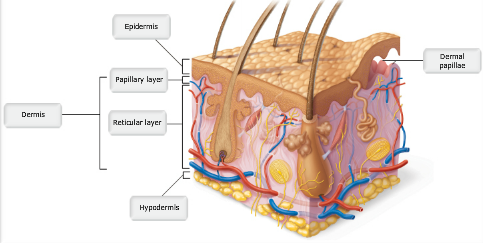
Drag the appropriate labels to their respective targets.
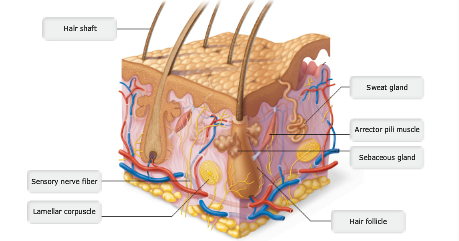
Drag the appropriate labels to their respective targets.
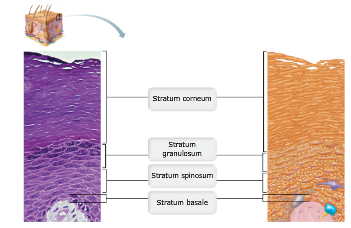
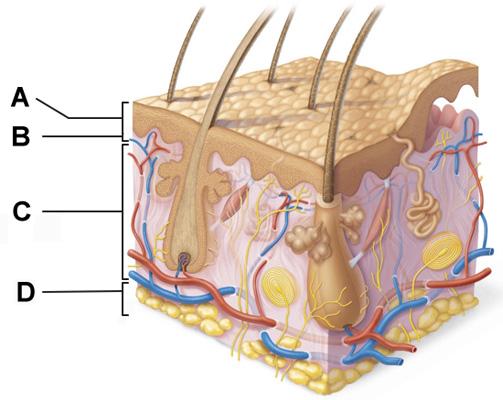
Which of the following terms describes layer D?
subcutaneous
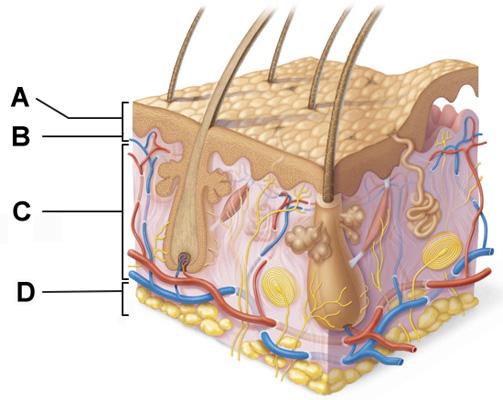
Which of the following correctly describes a common feature of all structures labeled A-D in the figure?
Structures A, B, C, and D are located in the dermis.
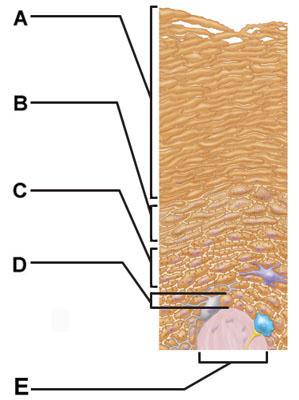
Which of the following would most likely be found in the stratum spinosum?
dendritic cell
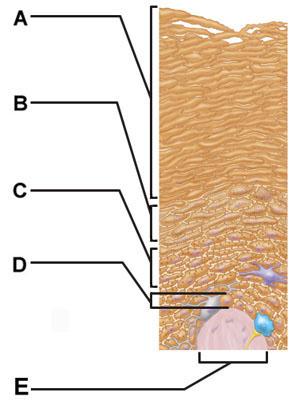
Which skin-color-associated, pigment-producing cell is located in the labeled layer D?
melanocyte
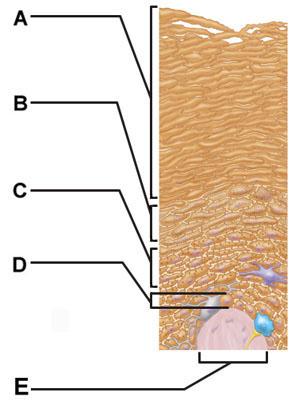
The structure indicated by label E is part of which of the following?
dermal papilla
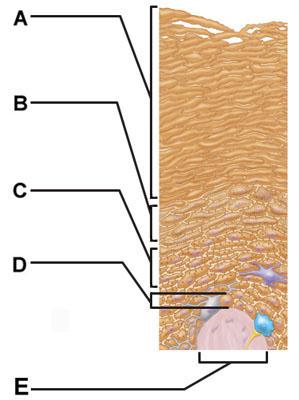
Transformed cells within labeled layer C give rise to which form of cell cancer?
squamous cell carcinoma
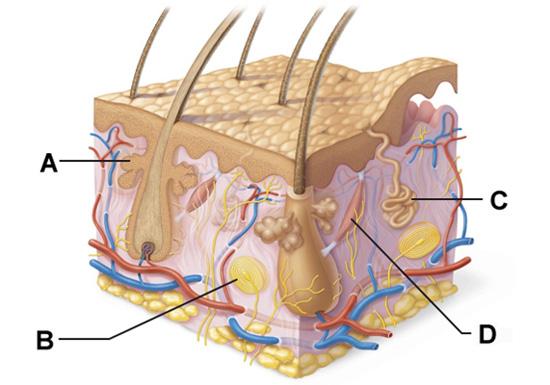
What is the function of structure B?
detection of pressure stimulus
The ________ is a thin translucent band found only in thick skin.
stratum lucidum
Which stratum of the epidermis is responsible for regenerating the more superficial layers?
stratum basale
Melanocytes and keratinocytes work together in protecting the skin from UV damage when keratinocytes ________.
accumulate the melanin granules on their superficial portion, forming a UV-blocking pigment layer
Water loss through the epidermis could cause a serious threat to health and well-being. Which of the following protects us against excessive water loss through the skin?
Lamellated granules of the cells of the stratum granulosum, a glycolipid that is secreted into extracellular spaces.
Despite its apparent durability, the dermis is subject to tearing. How might a person know that the dermis has been stretched and/or torn?
The appearance of visible, silvery-white scars is an indication of stretching of the dermis.
The design of a person's epidermal ridges is determined by the manner in which the papillae rest upon the dermal ridges to produce the specific pattern known as handprints, footprints, and fingerprints. Which of the following statements is true regarding these prints or ridges?
They are genetically determined, therefore unique to each person.
Which of the following statements indicates the way in which the body's natural defenses protect the skin from the effects of UV damage?
Prolonged exposure to the sun induces melanin dispersion, which in turn acts as a natural sunscreen.
Skin surface markings that reflect points of tight dermal attachment to underlying tissues are called epidermal ridges.
False
The dermis is rich in blood vessels and nerve fibers.
True
Which of the following represents a difference between eccrine sweat glands and apocrine sweat glands?
The secretions of apocrine sweat glands contain more fat and protein than do the secretions of eccrine sweat glands.
Which of the following statements is INCORRECT?
Tactile cells anchor the skin to the body.
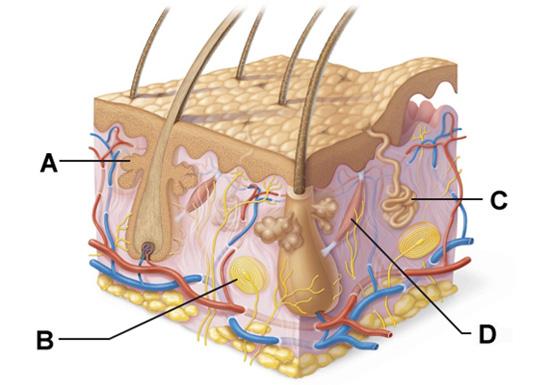
Which structure is a type of sudoriferous gland?
C
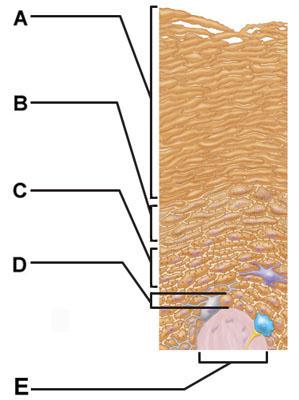
Cell division would be most common amongst cells in which of the labeled layers?
D
A needle would pierce the epidermal layers of the forearm in which order?
corneum, granulosum, spinosum, basale
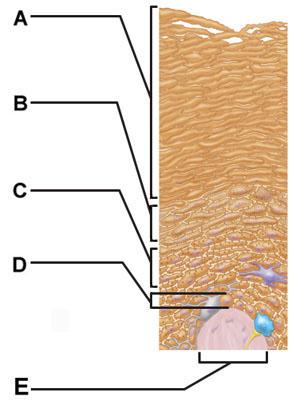
Most of the cells in layers A through D are of which type?
keratinocyte
Regardless of race, all human beings have about the same number of melanocytes.
True
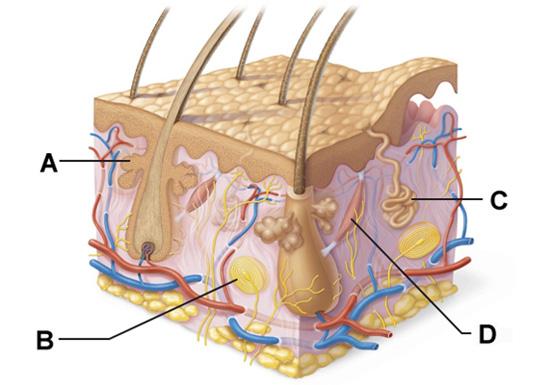
Which structure is a type of cutaneous sensory receptor?
B
Which of the following is a skin sensory receptor for touch?
Meissner's corpuscle
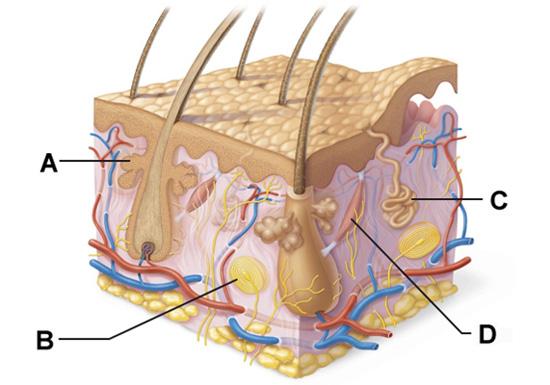
Which labeled structure produces an oily secretion?
A
Which skin pigment is made in the skin itself?
melanin
The most dangerous type of skin cancer is ________.
melanoma
The pinkish hue of individuals with fair skin is the result of the crimson color of oxygenated hemoglobin (contained in red blood cells) circulating in the dermal capillaries and reflecting through the epidermis.
True
A cancerous growth on the skin will likely exhibit ________.
asymmetry
Which of the following cutaneous receptors is specialized for the reception of touch or light pressure?
Meissner's corpuscles
A dendritic or Langerhan cell is a specialized ________.
phagocytic cell
The dense fibrous connective tissue portion of the skin is located in the reticular region of the dermis.
True
The epidermis consists of five layers of cells, each layer with a distinct role to play in the health, well-being, and functioning of the skin. Which of the following layers is responsible for cell division and replacement?
stratum basale
Which is the most common type of skin cancer?
basal cell carcinoma
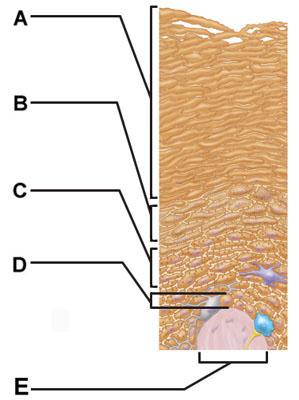
Which skin-color-associated, pigment-producing cell is located in the labeled layer D?
melanocyte
Which of the following is NOT a layer of the epidermis?
stratum reticulum
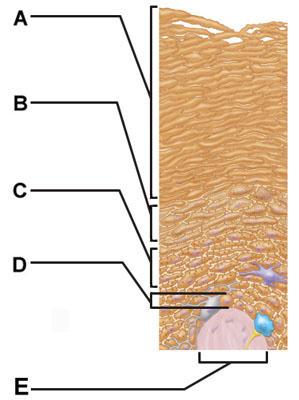
The structure indicated by label E is part of which of the following?
dermal papilla
The protein found in large amounts in the outermost layer of epidermal cells is collagen.
False
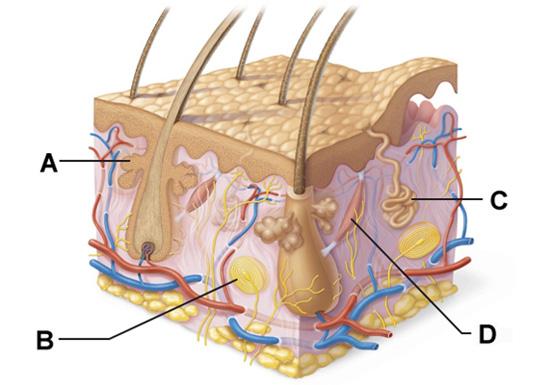
Which of the following terms describes layer D?
subcutaneous
The skin consists of two main regions. From deep to superficial they are the ________.
dermis and epidermis
Which layer of the dermis is directly below the epidermis?
papillary layer
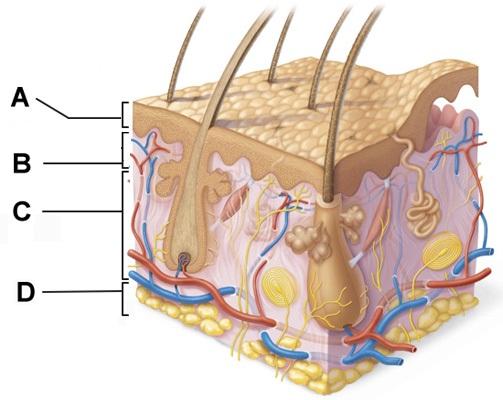
Layer B is composed primarily of ______.
areolar connective tissue
A needle would pierce the epidermal layers of the forearm in which order?
corneum, granulosum, spinosum, basale
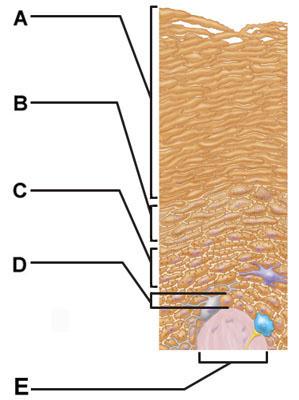
Cell division would be most common amongst cells in which of the labeled layers?
D
The protein found in large amounts in the outermost layer of epidermal cells is collagen.
False
The papillary layer of the dermis is connective tissue heavily invested with blood vessels. The superficial surface has structures called:
dermal papillae.
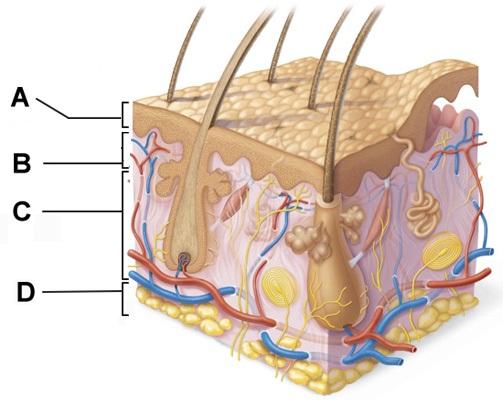
Which of the following terms describes layer D?
subcutaneous
The epidermis consists of five layers of cells, each layer with a distinct role to play in the health, well-being, and functioning of the skin. Which of the following layers is responsible for cell division and replacement?
stratum basale
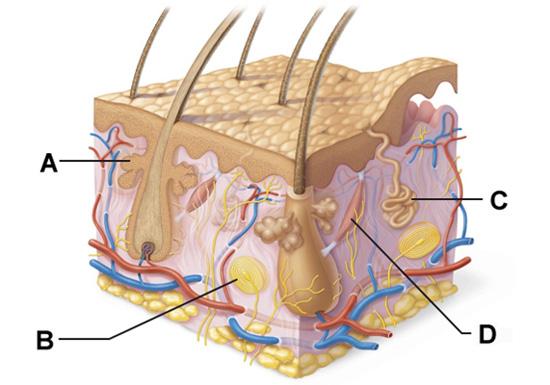
Which structure is a type of sudoriferous gland?
C
The integumentary system is protected by the action of cells that arise from bone marrow and migrate to the epidermis. Which of the following cells serve this function?
macrophages called dendritic cells (Langerhans Cell)
Sudoriferous (sweat) glands are categorized as two distinct types. Which of the following are the two types of sweat glands?
eccrine and apocrine
Which layer(s) of the skin is(are) damaged in a second-degree burn?
The epidermis and the superficial region of the dermis are damaged.
Which skin pigment is made in the skin itself?
melanin
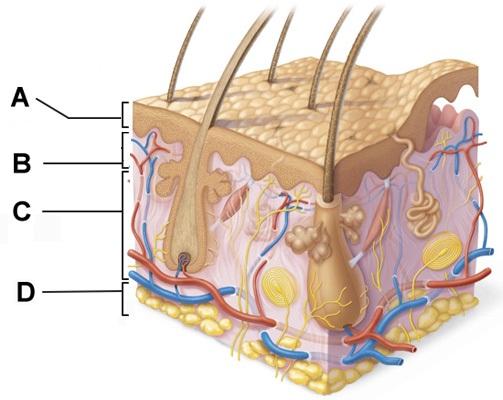
Layers B and C collectively form the ______.
dermis
Which of the following is NOT a layer of the epidermis?
stratum reticulum
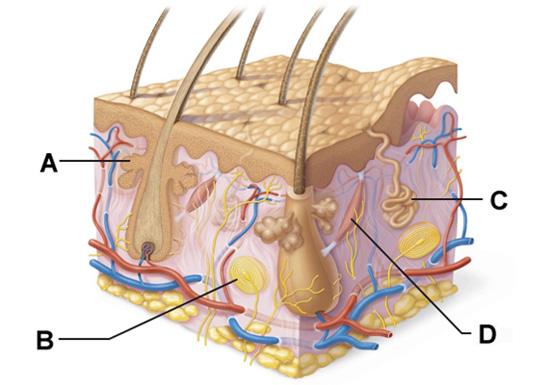
Which labeled structure produces an oily secretion?
A
Which of the following statements is INCORRECT?
Tactile cells anchor the skin to the body.
Regardless of race, all human beings have about the same number of melanocytes.
True
The biggest risk factor for the development of skin cancer is excessive exposure to ultraviolet radiation from sunlight.
True
Which is the most common type of skin cancer?
basal cell carcinoma
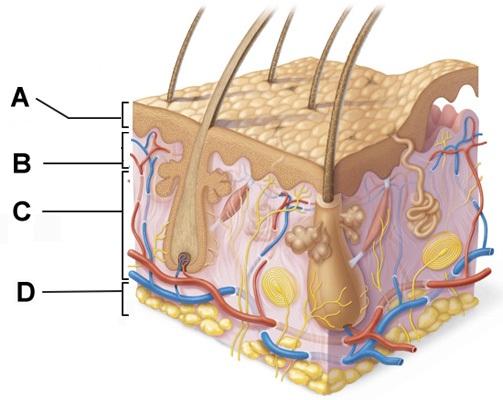
Which structure is a type of cutaneous sensory receptor?
B
Sweat is secreted by ________.
sudoriferous glands
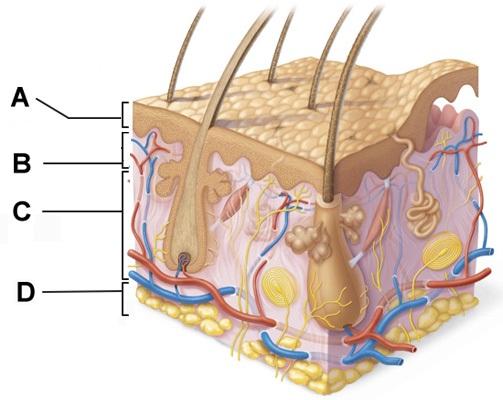
Which layer is composed primarily of stratified squamous epithelium?
A
The most dangerous type of skin cancer is ________.
melanoma
A cancerous growth on the skin will likely exhibit ________.
asymmetry
Apocrine glands, which begin to function at puberty under hormonal influence, seem to play little role in thermoregulation. Where would we find these glands in the human body?
in the axillary and anogenital area